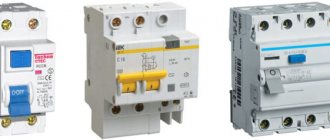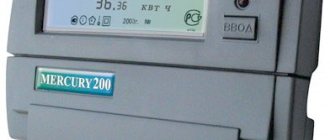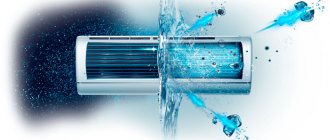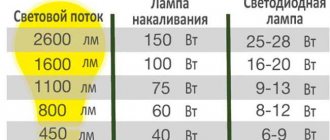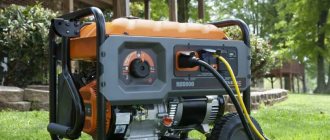15 Jul 2021
11746
What types of air conditioners are there? What is the difference between a split system and a monoblock? We analyze the types of air conditioners for apartments, their main functions, and calculate the power depending on the square footage. Pros and cons of the inverter.
- Air cooling and heating
- Remember about dry air
- We calculate the area of the room and power
- Choosing the type of air conditioner for the apartment
- Which energy efficiency class to choose
- Inverter or conventional air conditioner
- Comparison by noise level
- What are the operating modes of air conditioners?
- Additional functions in Haier air conditioners
- Installation feature
Air conditioning in the interior
Key parameters when choosing an air conditioner are power, energy consumption, engine type and health care functions. The inverter is quieter and consumes less energy. Additional functions that may be useful are room heating at sub-zero temperatures, an anti-allergen filter, self-cleaning and air humidification, and a UV lamp that removes viruses, bacteria and mold.
According to the sanitary rules and regulations of the Russian Federation (SanPiN) and GOST 30494-2011, the optimal air temperature in residential premises in summer is 22-25 °C, in winter - 20-22 °C. The World Health Organization's recommendations are similar: adults should sleep at a temperature no higher than 24°C, and children, older people and people with chronic diseases should sleep at a temperature no higher than 22°C.
In summer, the air outside the window warms up to 35 °C (not only in the south of the country, but also in the Urals and Siberia). A fan will not provide a comfortable temperature; it only disperses hot air. It is also impossible to keep windows open in the summer due to city noise, dust and insects. Air conditioning for home is the best option.
What is a split system in air conditioners: features
The split system is a design of two blocks: one is placed outdoors, the second is located in the room. Due to the complex device, the process of cooling the room occurs somewhat differently, but ultimately this gives advantages compared to a standard air conditioner.
Principle of operation
The two blocks interact with each other. The outdoor one creates condensation using a built-in compressor, and the indoor one creates the effect of evaporation. During operation of both units, refrigerant circulates. It passes through copper tubes, moving from liquid to vapor and back. The work is carried out through the following components:
- compressor;
- copper conductors;
- capacitor;
- evaporator;
- ventilation structure.
A split system does not cool the air as quickly as an air conditioner, but with constant operation it reduces energy consumption and increases the longevity of the drive.
Features of inverter models
The difference between inverter split systems and standard ones is the automatic temperature control function. Once you have set the appropriate room temperature, the compressor will start and increase the temperature. As soon as it is reached, the device will not turn off, but will operate at lower speeds, thereby preventing the temperature from changing quickly. When moving away from the set position, the fans will work faster. Due to this, split systems with inverter cooling last longer, since the compressor motor does not create sudden jerks.
What is better: a split system or an air conditioner for an apartment?
If you compare a split system with a standard air conditioner, the cost of the former will be approximately 25–50% more expensive. In essence, both units operate similarly, however, the inverter air conditioner will take a little longer to reach the set temperature, but then will constantly maintain it due to low fan speeds. This allows you to save on electricity.
The choice of device will depend on your preferences. If you are away every day and only run the air conditioner for a few hours, then it would be appropriate to install a standard all-in-one unit, since it quickly cools the air. The split system is designed to operate for a long time, so it lowers the temperature more slowly.
Summary
When purchasing an air conditioner for a simple room without strong sunlight, you can calculate the power of the equipment based on the area of the room. The resulting indicator will be quite sufficient so that the air temperature can be adjusted with the required accuracy, high speed and low energy consumption.
In cases where the object has a large ceiling height, a lot of equipment or people, it is worth using an extended formula that takes into account all heat inflows. This ensures that the purchased “split” can cope well with the cooling task and will not fail due to wear and tear.
Based on the calculated performance, it is very easy to select the desired air conditioner model, since the manufacturers of this equipment indicate this parameter directly in the equipment labeling. When choosing a unit, you should make sure that its power fully satisfies the needs of the facility.
Kinds
There are many types of split systems, which differ in power, location of operation and shape.
Wall-mounted
It is called household or domestic, since it is more often installed in residential premises. The advantage of this type is its low cost, since it can be purchased for 12,000 rubles. As a standard, the outdoor unit is installed under the window, and the indoor unit is mounted under the ceiling for a larger airflow radius.
Ceiling and floor-ceiling
This type of split system is less common, but convenient. The indoor unit can be installed at the bottom of the wall or on the ceiling, but only if you do not have a suspended ceiling. If the device is installed in the lower part of the room, then the air flow will be directed upward, and the ceiling air conditioner will blow horizontally. This will save you from direct hits, and the room will cool evenly.
There are improved designs that can simultaneously capture four directions, and using the control panel you can change the power of each of them.
Channel
The device is more often used in offices and shops, since its average power is 10–23 kW. A special feature of such split systems is the ability to cool several rooms at once. By default, the jet flow is supplied equally to all branches, so if you want to supply a separate temperature for each room, you will have to install additional electric drives and thermostats in each room.
Multi split systems
The device consists of one outdoor unit and several indoor ones. It allows you to cool up to 5 rooms at the same time, and the temperature of each unit can be changed using a remote control.
Due to the large number of hoses, compressors, conductors and fans, installing a multi-system is difficult and time-consuming. The design is most often used in complex business centers and industrial premises, which is why it is called industrial.
There are two types of multi split systems:
- Fixed. Provided as a ready-made kit. You can independently select the required number of indoor units. In the future, you will not be able to add or remove blocks yourself.
- Typeset. This option is distinguished by the ability to simultaneously connect a different number of blocks.
The universal device makes it possible to connect any type and type of unit.
Inverter
The inverter type of device is equipped with an electric drive that can automatically regulate fan speed. If you set the appropriate temperature, it will maintain it not by constantly starting the electric drive when the indicators change, but by constantly changing the speed. That is, the engine will run constantly, gradually changing speed. Such an electric drive is relevant in places where people are constantly present. These include offices, shops, conference rooms and other public places.
The inverter air conditioner differs from the standard one in lower energy consumption and greater engine wear resistance.
Split systems for allergy sufferers
For allergy sufferers, there are floor and wall air conditioners. A wall-mounted type of device will be more effective at purifying the air, since due to its complex design, improved filtration will occur. Externally, the split system for allergy sufferers is no different from the standard one, but it has a compartment for a filter. Budget models have limitations on the type of filters, since a complex filtration procedure will require a powerful compressor. Expensive split systems are equipped with several thresholds, creating stepwise filtration.
Designer models
The process of processing, cooling or heating air in designer split systems occurs in the same way as standard ones. The whole difference lies in appearance. Such split systems are usually distinguished by unique shapes and colors so that they can best match the interior.
Disguised air conditioners that represent paintings or some unique material are gaining popularity on the market. Moreover, the shape of the split system is no longer standard, but square, rectangular or rounded. As a rule, such devices are considered the most expensive.
What room characteristics should you pay attention to?
Before purchasing a split system, we recommend that you study the area of the room and take into account all the nuances. What exactly you need to pay attention to:
- Square. This characteristic is the most significant, since the capacity of the split system depends on it. According to the rule, 1 kW of electric drive power covers 10 square meters. meters of area. If the characteristics lag too far behind the area of the room, then the volume of the cooled zone will be smaller.
- Vertical dimensions. If you have high ceilings, then buy an air conditioner with a power reserve of 10–15%.
- Window. It is impossible to calculate this parameter to an exact match, since everything will depend on the time the sun's rays stay in the room. Also affects the temperature of the floor. As a rule, the highest floors warm up much faster than others, so it is recommended to install models with high power in such rooms.
- Stay of people. One person generates 100 W of heat in a calm state and 200 W in an active state. We add the number of people regularly in the room and find out the approximate power of the split system for effective use. For a home, this parameter is not so important, since the number of people may vary. But in offices or gyms, it is necessary to take into account the characteristics of the room and device.
If you decide to purchase a split system for an ordinary room or apartment, then the standard power and configuration will be sufficient.
Power (cooling capacity)
Usually the power is indicated in the passport. This parameter indicates the amount of warm air blown outside. Accordingly, the more powerful the cooling capacity, the faster the room is cooled.
Electric drive power
A powerful electric drive blows cold air further, so this criterion is also important when subtracting area. Staged filtration can impede air flow, so in special split systems the electric drive power is usually high.
Standard formulas for calculating suitable power (depending on area)
Calculation of the compliance of the area and power of the air conditioner is carried out in the following way: the exact area of the room is measured and, with a coefficient of 1 kW per 10 sq. m, the required power of the split system is measured. For example, if your room size is 13 square meters. m, then the power of the device should not be lower than 1.3 kW. Always take into account such nuances as the height of the ceiling, the regular presence of people in the room, the number of windows and the sunny side. Add another 10-15% power to each criterion.
What happens if you choose the wrong power?
If you incorrectly calculate the power of the split system, then the room will not be fully cooled. Moreover, the electric drive of the air conditioner will constantly operate at high speeds in order to reach the set temperature. This factor will significantly affect the service life.
If the power significantly exceeds the required ratio, then the drive will shut down frequently. In such a situation, the compressor of a standard air conditioner will quickly become unusable. However, for a split system, excess power is not so dangerous, since the electric drive will operate at lower speeds and turn off less often.
Heating function
The principle of operation for heating occurs in a similar way as for cooling, but only in reverse. The compressor of the outdoor unit creates compression of the freon, thereby heating it. Then the heated freon is transferred through tubes to the indoor unit and blown into the room.
If you compare a split system and any heating device, then when using the first, electricity will be consumed almost three times less. The reason for this is the difference in heat conversion. The split system uses electricity only to compress freon, which, after entering the indoor unit, will return back to be compressed again, and a conventional heater will convert heat directly from electricity.
Noise level
This parameter is no less important than power, since a high noise level during operation will cause you discomfort. The noise indicators of the device are indicated in its passport, but they are inaccurate. The manufacturer indicates the noise level at minimum speed of the electric drive, so we can safely add 20–30 dB to these indicators.
A conventional air conditioner runs at full speed to reach the set temperature. The split system gains momentum gradually and is correspondingly quieter. The required noise threshold depends on the room. In order not to experience discomfort in the bedroom, the operation of the split system should not exceed 30 dB, in the kitchen or in other rooms - 50 dB.
Air filtration and treatment
Air filtration is beneficial not only to humans, but also to the system itself. The external unit sucks in air from the street, where there may be poplar fluff, tree leaves and other debris that, if it enters the system, can disrupt its operation. The filter-capable device has a special compartment where the filter is located. Depending on the cost, there may be several levels of filtration and air treatment. Such models are intended mainly for allergy sufferers, as they block the entry of dirt, dust and other impurities into the room.
Housing material
The housing of the external unit is often made of metal. Cheap models use a regular iron body, which can be subject to rust. Expensive models are made of stainless steel. The housing of the indoor unit is made mainly of plastic.
Ionizer
With the help of an ionizer built into the split system, the air supplied to the room undergoes complex cleaning using ionized radiation. This has a positive effect on a person’s well-being, giving him energy and strength.
Smart sensors
Luxury split systems are equipped with a large number of sensors that increase comfort and reduce energy consumption. The motion sensor reacts to the presence of a person in the room. Many people mistakenly think that if the person in the room is inactive, the air conditioner will turn off, but this is not the case. The sensor is capable of responding not only to movements, but also to heat emitted by a person.
In addition to the standard temperature sensor, there are also air pollution and smoke sensors. The availability of additional features will depend on the cost of the split system.
Superfilters
Brands such as Toshiba have unique zeolite filters that are distinguished by their high level of purification and durability. The deodorizing function eliminates bacteria and other harmful substances from the room. Also, the advantages of a zeolite filter include the ability to clean it and use it endlessly, saving on disposable options.
Weight
The weight of the device depends on the material of the components and additional features. The external unit weighs between 15–20 kg, the internal unit – 4–8 kg. If the case material is not made of plastic, then the indicator may vary.
Compressor
Most often, rotary and piston compressors are installed in a split system. The best one is the rotary one as it is efficient and long lasting. The piston type is considered outdated because it can only be seen on older air conditioners. During the compression process of freon, friction occurs, and accordingly, the wear of parts accelerates. In this regard, previously the manufacturer’s warranty did not exceed 1 year.
Equipment and functions
Motion sensor – automatically switches the air conditioner to economy mode when there are no people in the room. Such air conditioners are expensive, but can significantly save energy.
Auto defrost – prevents ice from freezing on the outdoor unit in winter.
On/off timer – helps set the start and end time of the air conditioner.
Auto-cleaning – dries the internal parts of the air conditioner, thereby preventing the formation of mold and unpleasant odors.
Air pollution sensor - detects the presence of tobacco smoke, dust and other foreign impurities in the air. At a certain concentration of these impurities, the air conditioner automatically turns on (air purification mode). The device can turn itself off if the sensor no longer detects contaminants in the air.
Self-diagnosis - monitors the operation of device functions, identifies problems and displays relevant information on the screen.
Fan speed control - changes the intensity of heating or cooling of the air conditioner. The higher this parameter, the greater the amount of air passes through the indoor unit in a certain time.
Adjusting the direction of the air flow – changes the direction of the air flow in the direction specified by the user. This is done using special guides that are installed in the air conditioner.
Temperature setting – allows the user to set the desired cooling / heating temperature with an accuracy of one degree. Temperature range: 16-30 °C.
Warm start – does not supply cold air into the room and thereby protects against drafts (when operating in heating mode).
Display – displays information about the operation of the air conditioner (mode, temperature, humidity, etc.). Facilitates the operation of the device.
Auto restart – resumes the modes and settings of the air conditioner after the end of the operating cycle or emergency power off.
Water collection tray – used in mobile air conditioners to collect condensate. The smaller the volume of the tray, the more often it should be emptied and vice versa. In other types of air conditioners, condensate is discharged outside.
Remote control – used to control the air conditioner from a distance. The user can determine the mode, temperature, change the fan speed and make a number of other settings.
Remote control via Wi-Fi – allows you to control the air conditioner using a mobile device, such as a smartphone. This option makes it possible to turn on the device before coming home to create an optimal microclimate.
Wheels make it easy to transport the mobile air conditioner around the room.
Temperature sensor in the remote control – detects the temperature at the location of the remote control and independently regulates operation based on preset settings. Thus, an optimal microclimate is maintained near a person with a remote control.
Monitoring the cleanliness of filters - the system reports when filters are dirty, which prevents damage to the air conditioner.
Refrigerant leakage monitoring – sensors monitor the amount of refrigerant in the system. If there is a shortage of freon, these devices give a signal and turn off the unit. This allows you to avoid failure of the air conditioner.
Low temperature protection – automatic shutdown of the device when the outside air temperature drops below a specified parameter (minus 5-10°C). A useful option when operating the air conditioner in winter.
Current protection – enhances the reliability of the air conditioner.
All-season unit (winter set) – ensures operation of the air conditioner at negative temperatures (up to -30°C). Also, the “winter kit” is indispensable in rooms with a large number of heat-producing equipment (server rooms). This allows you to cool equipment in winter without reducing the level of air humidity - a critical factor for the operation of electronic devices.
Important: the air conditioner is not a heating device and is designed for heating in the off-season (spring, autumn). The lower the outside temperature, the lower the efficiency of the device. Consequently, an air conditioner at subzero temperatures consumes a significant amount of energy, generating relatively little heat. Therefore, for heating in winter it is better to use a specialized unit.
Drainage pump – a pump for pumping out condensate. It is an alternative to the traditional method of draining fluid through a tube. This solution allows you to use the air conditioner in winter and does not pollute the façade or the environment. It is used in situations where the drainage outlet is located above the level of the sump, which can be useful if the air conditioner is installed in the basement.
A protective box is a metal box with bars that covers the external unit on all sides except the bottom. Protects the device from theft and attacks by vandals. Useful if the unit is installed on the ground floor, on the roof, or located in another easily accessible location.
A protective canopy is a metal canopy that is mounted above the external unit. Used to protect the device from falling heavy objects, snow, and icicles.
The screen for the indoor unit (deflector) is a plexiglass product that is installed under the indoor unit. The deflector is designed for optimal distribution of cold air flow in the room. This ensures uniform cooling of the space and sharply reduces the risk of colds (if the internal unit of the device is installed above the workplace).
Markings from manufacturers
When purchasing a split system, you can immediately find out about its main parameters without taking out your passport. Basically, the brand markings are the same, but Chinese manufacturers may change it.
The box or block depicts a special code of letters and numbers, each of them indicates a specific characteristic, namely:
- refrigerant type;
- electric drive power;
- the lineup;
- type of power supply.
As a standard, the first letters indicate the brand name and block type.
Installation location
Before purchasing a device, you need to take care of its future location. This factor influences both comfort and optimal performance. During installation, it is recommended to comply with the following requirements:
- install so that the air flow does not enter the permanent residence of a person in the room;
- do not install the split system next to the bed, as the noise of the electric drive will cause discomfort;
- install only one air conditioner per room;
- observe the recommended values between the external and internal units.
The box with the device contains instructions with operating requirements, which are recommended to be studied.
Which split system company should you choose so as not to overpay for the brand?
On the market you can see a large number of split systems from various brands, which differ in cost, build quality and versatility. Not everyone can afford a luxury device with all the modern capabilities, so there are lesser-known companies that produce mid-range or budget split systems, but they are distinguished by high quality parts and durability.
The Green company is not the most popular, but it stands out for its robust body and a large number of functions, since even in economy class models you can see a built-in cleaning filter and several condensate drains.
Toshiba is a popular brand, but it has several middle-class models costing up to 22,000 rubles. This company has been on the market for many years, but the quality is still at a high level. The device has a built-in powerful but quiet electric drive, a cleaning filter, an ionization function and several operating modes.
The publisher named Roda is in great demand among the population, since the budget models produced are not much different from the luxury class. In addition to high-quality assembly, you can set your own settings in the split system and save them for future use. The air conditioners also feature multi-level filtration of air purification and automatic adjustment of electric drive power, with the help of which the device operates for a long time without disturbances.
If you compare a split system with an air conditioner, the first one wins in almost all respects. The only note is the gradual increase in temperature. Air conditioning costs less and is more efficient, but frequent shutdowns wear out the drive unit. For a small apartment with infrequent occupancy, an air conditioner would be the best option, but for larger areas, such as offices and boutiques, it is better to buy a split system, since it is less affected by the environment, and the process of cooling or heating the air is smoother.
Approximate energy consumption calculations
Myths about the prohibitively high energy consumption of split systems lack convincing justification . Often, incorrect information appears because users confuse the concepts of power produced and power consumed.
In fact, the energy consumed by the equipment is less than the energy output. This can be seen in the example of the same popular household model from AUX. Looking at its technical characteristics, we see that in cooling mode the device draws 650 W and produces 2100 W.
Any split system consumes three times less energy than it produces. Equipment efficiency is approximately 250%. The main part of the energy is spent on pumping and converting the refrigerant, which is provided by the mechanisms included in the system
Model ASW-H07A4 for rooms of 20-25 m² works on the start/stop principle, consuming about 0.7 kW/h. To calculate how much this split system consumes per day and month, let’s assume that it is turned on for 8 hours a day.
It is worth considering that the equipment will use full power only when it reaches the desired temperature. The compressor is in an economical standby mode for a certain period.
Even if you take it to the maximum, the device will consume no more than 5.6 kW per day, and 168 kW per month.
According to the tariff for the population in force in 2022, 1 kW will cost 5.38 rubles. This means that operating an air conditioner per day will cost no more than 30 rubles, per month – no more than 900 rubles.
We emphasize that the above calculations are approximate, since they do not take into account the operating features of the device.
In individual calculations of energy consumption of climate control equipment, various nuances are taken into account. The consumption is affected by the number of working hours per day, the location of the room on the sunny side, the temperature outside the window and other factors.
Overall costs can be lower when choosing equipment with an inverter compressor, saving up to 40% of energy resources without wasting power. On average, such devices consume about 0.5-0.6 kW/h.
Compared to some household appliances, a split system, which consumes 0.5-1 kW/h depending on the power of the model, works more economically.
For example:
- a regular iron consumes 2-2.5 kW/h;
- the heater draws at least 2 kW/h;
- the refrigerator takes 1-1.5 kW/h;
- a washing machine requires up to 2.5-5 kW/h;
- electric kettle - 1.5-2 kW/h.
A computer and plasma TV consume less electricity.

